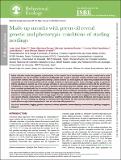Por favor, use este identificador para citar o enlazar a este item:
http://hdl.handle.net/10261/270880COMPARTIR / EXPORTAR:
 SHARE SHARE
 CORE
BASE CORE
BASE
|
|
| Visualizar otros formatos: MARC | Dublin Core | RDF | ORE | MODS | METS | DIDL | DATACITE | |

| Título: | Made-up mouths with preen oil reveal genetic and phenotypic conditions of starling nestlings |
Autor: | Soler, Juan José CSIC ORCID; Martínez-Renau, Ester CSIC ORCID; Azcárate-García, Manuel CSIC ORCID; Ruiz-Castellano, Cristina CSIC ORCID; Martín Rueda, José CSIC ORCID ; Martín-Vivaldi, Manuel CSIC ORCID | Palabras clave: | Antioxidants Begging Genetic component Makeup hypothesis Parent-offspring communication Signaling Uropygium Vitamin E |
Fecha de publicación: | may-2022 | Editor: | Oxford University Press | Citación: | Behavioral Ecology 33(3): 494-503 (2022) | Resumen: | Animal coloration results from pigments, nanostructures, or the cosmetic use of natural products, and plays a central role in social communication. The role of cosmetic coloration has traditionally been focused in scenarios of sexual selection, but it could also take place in other contexts. Here, by using spotless starlings (Sturnus unicolor) as a model system, we explore the possibility that nestlings cosmetically use their intensely yellow-colored uropygial secretion to signal their genetic and/or phenotypic quality. In agreement with the hypothetical cosmetic use of the uropygial secretion, (i) video recorded nestlings collected secretion with the bill at the age of feathering, (ii) cotton swabs turned to the color of secretion after rubbing with them nestlings’ gape, and (iii) gape and skin colorations correlated positively with that of secretion. Furthermore, we found that (iv) secretion coloration has a genetic component, and (v) associated positively with Vitamin E supplementation and (vi) with plasma carotenoid concentration, which highlights the informative value of nestling secretion. Finally, (vii) coloration of begging-related traits and of secretion of nestlings predicted parental feeding preferences. Consequently, all these results strongly suggest that the cosmetic use of colored uropygial secretion might also play a role in parent-offspring communication, complementing or amplifying information provided by the flamboyant colored gapes and skin of nestlings. The use of makeups by offspring for communication with relatives has been scarcely explored and we hope that these results will encourage further investigations in birds and other taxa with parental care. | Versión del editor: | https://academic.oup.com/beheco/article/33/3/494/6563374 | URI: | http://hdl.handle.net/10261/270880 | DOI: | 10.1093/beheco/arac024 | ISSN: | 1045-2249 | E-ISSN: | 1465-7279 |
| Aparece en las colecciones: | (MNCN) Artículos (EEZA) Artículos |
Ficheros en este ítem:
| Fichero | Descripción | Tamaño | Formato | |
|---|---|---|---|---|
| Martín_J_Made_up.pdf | Artículo principal | 26,52 MB | Adobe PDF |  Visualizar/Abrir |
CORE Recommender
SCOPUSTM
Citations
2
checked on 30-abr-2024
WEB OF SCIENCETM
Citations
2
checked on 25-feb-2024
Page view(s)
44
checked on 30-abr-2024
Download(s)
53
checked on 30-abr-2024
Google ScholarTM
Check
Altmetric
Altmetric
NOTA: Los ítems de Digital.CSIC están protegidos por copyright, con todos los derechos reservados, a menos que se indique lo contrario.
